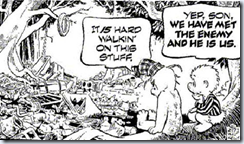(1948-1972)
Written and drawn by Walt Kelly
Wikipedia Page
 There are many contenders for the best newspaper comic strip of all time. Krazy Kat was amazingly good, but most people didn’t get it. Peanuts was great, and massively popular. Calvin and Hobbes was great in all respects. There are also cases to me made for Doonesbury, Barnaby, Mickey Mouse, Little Nemo in Slumberland, and Dick Tracy.You can add others to the list, but any list worth its salt has to include Pogo.
There are many contenders for the best newspaper comic strip of all time. Krazy Kat was amazingly good, but most people didn’t get it. Peanuts was great, and massively popular. Calvin and Hobbes was great in all respects. There are also cases to me made for Doonesbury, Barnaby, Mickey Mouse, Little Nemo in Slumberland, and Dick Tracy.You can add others to the list, but any list worth its salt has to include Pogo.
Pogo was created by Walt Kelly. Kelly had started out as an animator for Disney, working on Pinocchio, Fantasia, and Dumbo, among other things. But he left after the animator’s strike to work for Dell Comics, where he did the first versions of the strip. Pogo was originally a minor character, but he eventually became the center of the comic.
In 1948, he was hired as an editorial cartoonist for the short-lived New York Star, where he convinced them to run Pogo as a regular strip. The Star folded in January of 1949, but Kelly managed to find a syndicate to take over the strip. It debuted in May.
Pogo was a funny animal strip, dealing with the foibles of the denizens of Okefenokee Swamp.* The title character is a possum, gentle and kindly, who observes and often is the victim of the madness around him. His best friend in Albert the Alligator, who’s loud, bombastic, and egotistical, but a good friend to Pogo. There’s also Howland Owl, the master of misunderstanding and creating hairbrained schemes, and his friend, Churchy LaFamme, poet, who’s close friends of Owl and falls gullibly to aid him in his schemes.** There’s also Porky Pine, Pogo’s friend, the confirmed cynic who never smiles, and Miz Mademoiselle Hepzibah, a skunk who is Porky’s love interest.
A list of characters would go on for pages and pages. Kelly created them constantly, and somehow managed to juggle them all; even given its long run, it still has many more named and identifiable ongoing characters than just about any strip. They could disappear for weeks and years at a time and still be instantly recognizable.
The strip also wasn’t afraid to get involved in politics, and was probably the first non-editorial newspaper comic that had a specific political slant. Most famous was its use of the character of Simple J. Malarkey, an obvious character of Joseph McCarthy, created at the height of McCarthyism. Kelly also created the Cowbirds, who represented American communists, a pig that looked like Nikita Khrushchev, and many others. Any newspaper comic that comments on politics owes a debt to Pogo,

But the political satire was only a small part of comic strip.Most of it involved Owl’s hairbrained schemes, misunderstandings and delightful madness. There was some amazing wordplay, all done in a special “swampspeak” dialect that was probably the most successful way of portraying one ever written. Kelly also loved to write poems for his characters (usually Churchy), most notably his contribution to Christmas:

In addition to being a fine writer, Kelly was a great comic artist. The characters were simple, but full of life, and the backgrounds were incredibly detailed. Kelly often used rough lines to separate panels instead or straight ones.
He was also an innovator in lettering. P.T. Bridgeport, a circus barker, spoke in lettering like a circus poster. Deacon Mushrat spoke in a gothic font. Sarcophagus MacArbre, a buzzard who was an undertaker, has square, black-bordered speech balloon with his words in script.
Pogo’s influence on comics is immense. Anyone who did a political comic owes a debt, of course, but it’s clear that some of the great talents in the field were fans. Alan Moore wrote an episode of Swamp Thing called “Pog,” where the characters were aliens who clearly looked like Pogo and Albert. In Jeff Smith’s Bone, Smiley Bone is clearly based on Albert.
Oddly, the comic never broke into other media. There was a half-hour animated show, directed by the great Chuck Jones, but despite the talent involved, it wasn’t very good.*** Merchandising wasn’t all the big, either, though Dell did produce a Pogo comic book.
The strip ended with Kelly’s death in 1972. An effort was made to keep it going by his widow Selby, but no one could replace him, and the smaller size of the panels made it difficult for anyone to fit it the wordplay and meticulous art that Kelly excelled in. The strip ended in 1975.
It was revived briefly in 1989. The new version couldn’t hope to compete with the original, but it evolved into a decent strip once you stopped comparing it. Alas, it only lasted until 1993.
_____________________________________________________
*A real place in Georgia, though probably without talking animals.
**He’s always superstitious: He showed up on the 13th of each month to saying “Friday the thirteenth is on a Tuesday (or whatever) this month!”
***Jones and Kelly did some of the character voices, too, with June Foray as Pogo
(1966)




